NYMPHEA

Loire Valley: River Cher
up to 6 guests
Charters and Cabin cruises
Themed Cruises:
Bike, Family, Golf, Honeymoon

The Cher River is approximately 200 miles (320 km) long, beginning in the Massif Central and flows northwest across central France to join the Loire River below Tours. The impressive Château de Chenonceau spans the Cher River and you can navigate through the arches under the chateau. The Berry Canal parallels part of the river.
CHATEAU DE VILLANDRY - AMBOISE - CHATEAU D'AMBOISE - CLOS-LUCE - CHATEAU DE CHENONCEAU - BOURRE: La Magnanerie - VALENCAY: Cheese/Wine/Memorial - CHATEAU DE VALENCAY - CHATEAU DE NITRAY - GOLFING
River Cher between Tours / Saint-Pierre-des-Corp and Montrichard
The Château de Villandry is located in Villandry, Indre-et-Loire, France. The lands were known as Colombier until the 17th century. The 14th-century keep is where the Paix des Colombiers was signed on July 4, 1189, where King Henry II Plantagenet of England acknowledged defeat by King Philippe Auguste of France.

Acquired in the early 16th century, Château de Villandry was completed in 1536, by Jean le Breton, one of King Francis I's finance ministers and also ambassador to Italy where he had devoted his spare time to study of the Italian Renaissance gardens. Villandry is considered the last of the major Renaissance châteaux to be built in the area.
Château de Villandry remained in the Le Breton family for over 200 years and then was acquired by the Marquis de Castellane. The Marquis, a powerful ambassador from a family of nobles from Provence, constructed the beautiful outbuildings around the château, and redesigned its interior to bring it up to 18th century standards of comfort. The property was confiscated during the French Revolution. In the early 1800's Emperor Napoleon acquired it for his brother Joseph Bonaparte.
By the turn of the century, Villandry had fallen into terrible disrepair and was on the brink of being demolished. In 1906, Joachim Carvallo purchased the property and poured a great amount of time, money and devotion into repairing it and creating what many consider to be the most beautiful gardens anywhere. Its famous Renaissance gardens include a water garden, ornamental flower gardens, and vegetable gardens. Château de Villandry is known for its formal gardens which occupy eight full time gardeners that tend to its five hectares. There are over 1200 lime trees, large vineyards and over 50 kilometers of box hedge. In 1934, Château de Villandry was designated a Monument Historique. Like all the other châteaux of the Loire Valley, it is a World Heritage Site.

Still owned by the Carvallo family, the Château de Villandry is open to the public and is one of the most visited châteaux in France.

On the south bank of the Loire, 23km upstream from Tours, the pretty riverside town of Amboise has built up around the fortified Château d'Amboise and the Clos-Lucé where Leonardo da Vinci spent the last three years of his life.
One interesting piece of modern art in Amboise is a twentieth-century fountain by Max Ernst of a turtle topped by a teddy bear figure, standing in front of the spot where the market takes place every Saturday and Sunday morning by the riverside.
Chateau d'Amboise has been home to some important historical figures and events. In the 15th and 16th centuries, the Château d'Amboise became a royal palace. Both Charles VII and VIII stayed here. After a trip to Italy, Charles VIII was inspired to undertake improvements to the château. Charles should have remodeled the stairways as he died after hitting his head on a low lying lintel.

Francis I based his court here. He and his sister, Margaret of Angouleme, hosted lavish balls, plays and tournaments of all sorts at the château.
The château was the stage for the Amboise Conspiracy, an ill-fated Protestant plot against François II. The Salle des Etats was the scene of the hanging of 1200 Huguenots after their attempt in 1560 to overthrow Francis II failed.

The château also boasts some famous architectural features such as the Tour des Minimes which drops down the side of the cliff, enclosing a massive circular ramp designed to lead horses and carriages up the steep hillside, and also the Chapelle-St-Hubert with its carvings of the Virgin and Child, Charles VIII, and Anne of Brittany, and once graced by the tomb of Leonardo de Vinci.
Numerous son-et-lumière shows take place throughout the summer season. Visitors can enjoy a spot of wine-tasting at the Caveau des Vignerons d'Amboise just within the castle walls. In 2009, the maze of underground passages were newly opened to the public for guided visits.
This residence of pink brick was built by Hugues d'Amboise on Gallo-Roman foundations in the reign of Louis XI (between 1107 and 1115). The property was then given by the king to his favorite, Etienne le Loup, a cook's assistant whom he ennobled. The estate, which was called the Manoir du Cloux at that time, was surrounded by fortifications, all that remains today being the watchtower. At the bottom of the park, Etienne le Loup also had a dovecote, which is still intact, and housed 500 pigeons.

Bought by Charles VIII in 1490, the castle became a royal estate and to remain so for two centuries. While the Royal Court resided at the Château d'Amboise in the Loire Valley, the Manoir du Cloux was used as a secondary residence. Charles VIII had the chapel built here for the Queen, Anne de Bretagne, in mourning for her children who died young.
It was under Francis I that Le Clos-Lucé became the house symbolising the Renaissance movement in France. Advised by his sister, Marguerite de Navarre, Francis I had painters, architects, and poets, such as Clément Marot, who were seeking royal protection, brought here. Following his campaigns in Lombardy, François I decided that the best way to bring back the ideas of the Italian Renaissance was to import one of the finest exponents of the new arts. In 1516, Leonardo da Vinci ventured across the Alps in response to the royal invitation, carrying with him three of his most remarkable paintings, the Mona Lisa, St. Anne, and St. John the Baptist, which he completed at Le Clos Lucé. For three years before his death in 1519, he made his home at the Clos-Lucé, where Leonardo seems to have enjoyed a semi-retirement at Amboise, devoting himself to his art and inventions, and enjoying conversations with his royal patron.
Interesting exhibits such as the Halle Interactive which contains 40 working models of his machines, built by IBM engineers using the detailed sketches in the artist's notebooks. Mechanisms on display include three-speed gearboxes, a military tank, a clockwork car, and a flying machine complete with designs for parachutes.
Built on the river Cher, where the unique beauty of its architecture reflects in the water, the Château de Chenonceau is one of the more romantic châteaux of the Val de Loire with elegant turrets, arches and stately avenues bordered by plane trees.

Château de Chenonceau, or the Château des Dames as recorded in the French history books, owes a large part of its charm to women...
Katherine Briçonnet (whose husband, Thomas Bohier, bought the site on the proceeds of embezzling from his master, Francis I) hired the first architects in 1515 and had them begin building on the foundations of an old mill that stood on the granite bed of the Cher. The château was seized from Bohier's son by Francis I for unpaid debts to the Crown, and after Francis' death in 1547, King Henri II offered the château as a gift to his mistress, Diane de Poitiers. Thus, the château's most characteristic feature, the set of arches spanning the River Cher, was begun by Diane de Poitiers. They were completed by the indomitable Henri's wife, Catherine de Médicis. After King Henri died in 1559, Catherine, his strong-willed widow and regent, evicted Diane and forced her to hand over the Château in exchange for Château de Chaumont (not exactly an even swap!)

Mary, Queen of Scots, child bride of Francis II, also spent time at Chenonceau until her husband's early death.
Then, after a long period of disuse, one Madame Dupin brought 18th century life to this gorgeous residence, along with her guests Voltaire, Montesquieu and Rousseau, whom she hired as tutor to her son. Restoration back to the 16th century designs was completed by another woman, Madame Pelouze, in the late 19th century.
The Château de Chenonceau changed hands many, many times and has very interesting stories to tell... if walls could talk!
In 1913, the Menier family, famous for their chocolates, bought the Château and still own it to this day.
During World War I, the gallery was used as a hospital ward; during the Second War, it was a means of escaping from the Nazi occupied zone on one side of the River Cher to the "free" Vichy zone on the opposite bank.
In 1951, the Menier family entrusted the château's restoration to Bernard Voisin, who brought the dilapidated structure and the gardens (ravaged in the Cher River flood in 1940) back to a reflection of its former glory.

The Château de Chenonceau is not only remarkable for its architecture and history, but also for the fine quality of its collections as can be seen from the inside visit: Renaissance furniture, a vast ensemble of 16th and 17th centuries tapestries and a great number of masterpieces. Le Primatice, Rubens, Le Tintoret, Rigaud, Nattier, Van Loo are among the most famous names that can be found there.
An architectural mixture of late Gothic and early Renaissance, Château de Chenonceau and its gardens are open to the public. Other than the Royal Palace of Versailles, Chenonceau is the most visited château in France.
Three kilometres to the east of Montrichard, the hills around troglodyte village of Bourré are riddled with enormous, cave-like quarries, dug deep to get at the famous château-building stone that gets whiter as it weathers. Some of the caves are now used to cultivate mushrooms. At the bottom of the hill, you can visit the troglodyte houses and 17th century silkworm-breeding farm deep in the caves at La Magnanerie.
Valençay Cheese

Named after the town in central France, Valençay is shaped like a pyramid with the top cut off. It is a soft, uncooked, unpressed, 45% fat goat cheese, still made following the traditional method. When the cheese is firm enough, it is covered with salted charcoal ash allowing Valençay to keep its flavor for a long time. As it matures in a ventilated cellar at 80% of humidity, a natural blue mold covers the cheese.
The story goes that Napoléon stopped in Valençay on his return from his failed campaign to conquer Egypt. When he saw this pyramid-shaped cheese he was so enraged that he drew his sword and angrily lopped off its top.
Valençay Wine
Valençay is a recently promoted AOC wine appellation (it gained AOC status in 2004) in the Loire region of France that adjoins the Touraine appellation. Some of the most successful vine varieties are Sauvignon Blanc but crisp red, white and rose wines designed to be drunk young are also made from Cabernet, Cot, Gamay, Pinot Noir, Chardonnay and Arbois.
Valençay Memorial

The Valençay SOE Memorial is a monument to the members of the Special Operations Executive F Section who lost their lives for the liberation of France. The memorial was unveiled in the town of Valençay on May 6, 1991, marking the fiftieth anniversary of the despatch of F Section's first agent to France. It was designed by Elizabeth Lucas and entitled "Spirit of Partnership". Dedicated by the Minister of Veterans Affairs for France and Queen Elizabeth The Queen Mother, the memorial's Roll of Honour lists the names of the 91 men and 13 women members of the SOE who gave their lives for France's freedom.
Valençay was constructed in 1540 on the site of a demolished earlier castle by Robert d'Estampes; a project which was to occupy his family for the best part of 200 years. John Law, the Scottish banker, acquired the property in 1719. In 1803, the castle was purchased by the diplomat Charles Maurice de Talleyrand, Foreign Minister to Napoleon. Ferdinand VII of Spain spent six years at Château de Valençay in Napoleonic gilded captivity.

During the Second World War the château was spared by the occupying German forces because the owner at the time, the Duke of Valençay, managed to establish his neutrality as Prince de Sagan (duchy of Sagan in Prussian Silesia, now part of Poland). On this technicality, treasures from the Musée du Louvre like the Winged Victory of Samothrace and the Venus de Milo were safely sheltered in the Château.
In 1979 the Château was sold to an association of historic Chateaux.
Talleyrand's château boasts one of the most advanced interiors of the Empire style anywhere. There are a hundred rooms, of which a quarter comprise Talleyrand's apartments. A room of King Ferdinand is also shown to tourists. The western wing contains the Talleyrand Museum, formerly housed in outbuildings, and Le Musée de l'Automobile du Centre, exhibiting over fifty vintage and antique automobiles.
The gardens are as much a highlight as the castle, well maintained and extensive. The formal French gardens, dating from the early 20th century, cover about forty hectares, not counting the area of Talleyrand's vineyards. There are also parks and woods to be explored, teaming with deer and peacocks, plus recently created series of large meadows.

This exceptional architectural ensemble from the 15th and 16th centuries with its chapel, pigeon house, and large landscaped Engish garden, is the beginning point for following one of the most beautiful paths in Tourraine, followed in times past by Chopin, Balzac and Georges Sand. Nitray is also a large winemaking estate.
